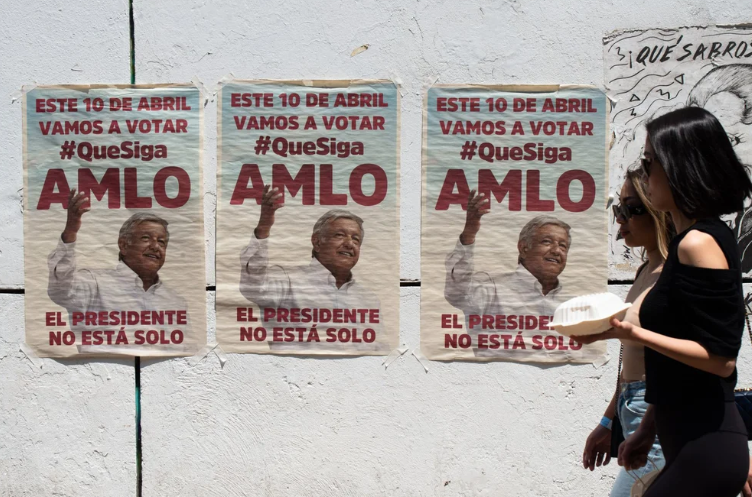The most important data that the mandate revocation act produced were the 15 million votes that President Andrés Manuel López Obrador (AMLO) received in favor of his continuity. Given that the action was promoted by and from the government, the figure can be interpreted as AMLO’s hard vote or, if you prefer, a measure of the government’s capacity to mobilize its voters. Is fifteen million too few or too many, you may ask. Depending on how you look at it. Some of us think they are not so many since they are equivalent to 16 percent of the electorate. Not an insignificant figure by any means, but it casts doubt on the president’s supposed enormous popularity. This data makes us think that perhaps we are facing a well-known phenomenon in Mexico: the discrepancy between popularity and electoral support for the president. The lesson of the consultation would be that although AMLO and his party seem unbeatable in the media and social networks, electorally it is perfectly possible to defeat them.
Let’s start by saying that this revocation, officially called the Process for the President of the Republic’s Mandate Revocation elected for the constitutional period 2018-2024, was a big pantomime. The story goes back to August 2021 when the Federal Law of Revocation of Mandate was approved. This law was intended to give the citizenry a tool to disagree with the executive and, ultimately, remove it from office peacefully and legally. But it is well known that the road to hell is full of good intentions. In this process, what was intended as a tool of direct democracy to empower the citizenry was captured by the government to mobilize its base. In fact, and against all logic, the revocation of the president’s mandate was promoted from the beginning by AMLO’s government itself. The world upside down.
It is clear then that this procedure does not really qualify as a revocation consultation, since it does not respond to genuine citizen’s demand. It was rather an exercise of government mobilization like those we see in semi-authoritarian countries. However, from a political analysis, the process was of great value as it allowed us to clearly observe the true electoral muscle of the president. I say electoral muscle and not popularity because if anything was evident in the April 10 session is that one and the other are not the same. The difference is key since one of the strategies AMLO uses to divide and paralyze the opposition is to point out that he has record levels of popularity.
Here’s a word of caution: this assertion has clearly been proven to be a myth. Indeed, at this point in their six-year terms, Presidents Salinas, Zedillo, Fox, and Calderón had similar approval ratings hovering around sixty percent (Peña Nieto’s abrupt drop in popularity is the exception, not the rule). In spite of this, the pro-government spokespeople repeat every day that this president is the most popular in Mexico’s history. AMLO himself even likes to share polls in his morning conferences that place him as one of the world leaders with the highest approval ratings. This is no accident; on the contrary, it is a deliberate strategy to create a favorable narrative for his government.
The other key aspect that the consultation demonstrated was that AMLO continues to be a politician very capable of bending the law to get his way. Examples abound. Let’s start by saying that the National Electoral Institute (INE) detected that 1 out of 4 petition signatures to carry out the consultation were false. Let’s continue with the fact that the President cut INE’s budget to carry out the consultation under the argument of austerity. And let’s finish by saying that neither he nor his party respected the electoral ban (the law establishes that parties may not interfere in the recall campaign).
I repeat: none of this is accidental. Political scientist Alberto Simpser, in his book “Why Governments and Parties Manipulate Elections: Theory, Practice, and Implications”, points out that political actors in power can openly and unabashedly violate the rules to send a powerful message: I have the power and audacity to break the law and do as I please. According to Simpser, “electoral manipulation can potentially yield substantially more than simply winning the election at hand. Specifically, excessive and blatant manipulation has a series of intended effects that include, among other things: to discourage opposition supporters from turning out to vote or to protest; […] to deter political elites from opposing the ruling party or from even entering the political fray”.
All of the above produce key data. First, AMLO’s hard vote is to a certain extent relatively small, not negligible of course, but not unbeatable either. Second, it is very likely that we are witnessing a case of deliberate magnification of AMLO’s image as a popular president based on two strategies. The first one would be the construction of a narrative around him as an exceptionally popular president – we have already seen that the data indicate that this is a myth. Second, the way he acts as a politician who is very willing to break the rules of the electoral game in plain sight would give him a psychological advantage.
Narrative and psychology are very important in political scuffles, no one denies that. But data is king. And what it tells us is that this president can be defeated electorally. Is AMLO, then, a sort of Wizard of Oz of Mexican politics?
Translated from Spanish by Janaína Ruviaro da Silva













